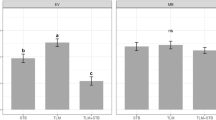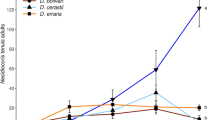Abstract
Plants with glandular trichomes may provide protection against herbivores by impeding their movement, but may also hinder natural enemies. We investigated walking behavior and predation rates of the mirid predators Campyloneuropsis infumatus, Engytatus varians, and Macrolophus basicornis on two tomato lines with different densities of sticky trichomes. Also, the time spent by each predator species in various activities (immobile, walking, grooming, probing, and feeding) and the searching for and handling time of prey, eggs of Tuta absoluta, were observed. Tomato lines TOM 587 and TOM 687 were used, with TOM 687 having a 179% higher density of glandular trichomes. All three mirid predators easily climbed the sticky stems of both tomato lines and found eggs of T. absoluta on leaflets located on the top of the plants. Predation rates, grooming, probing, and feeding activities and the time spent by the three mirid predators until prey encounter were not influenced by a difference in density of trichomes on the two tomato lines. However, E. varians walked longer on TOM 584, and spent more time grooming than M. basicornis. Macrolophus basicornis walked longer on TOM 687. Our results show that the three mirid predators are apparently specialists of glandular plants, because differences in trichome density do not influence their activities, including their prey finding efficiency.




Similar content being viewed by others
References
Barbour JD, Farrar RR, Kennedy GG (1993) Interaction of Manduca sexta resistance in tomato with insect predators of Helicoverpa zea. Entomol Exp Appl 68:143–155
Barbour JD, Farrar RR, Kennedy GG (1997) Populations of predaceous natural enemies developing on insect-resistant and susceptible tomato in North Carolina. Biol Control 9:173–184
Björkman C, Ahrné K (2005) Influence of leaf trichome density on the efficiency of two polyphagous insect predators. Entomol Exp Appl 115:179–186
Botega DB, Souza BHS, Rodrigues NEL, Eduardo WI, Barbosa JC, Boiça Junior AL (2017) Resistant and susceptible tomato genotypes have direct and indirect effect on Podisus nigrispinus preying on Tuta absoluta larvae. Biol Control 106:27–34
Bueno VHP, Montes FC, Pereira AMC, Lins JC Jr, van Lenteren JC (2012) Can recently found Brazilian hemipteran predatory bugs control Tuta absoluta? IOBC WPRS Bull 80:63–67
Bueno VHP, van Lenteren JC, Lins JC Jr, Calixto AM, Montes FC, Silva DB, Santiago LD, Pérez LM (2013) New records of Tuta absoluta (Meyrick) (Lepidoptera: Gelechiidae) predation by Brazilian Hemipteran predatory bugs. J Appl Entomol 137:29–34
Bueno VHP, Calixto AM, Montes FC, van Lenteren JC (2018) Population growth parameters of three Neotropical mirid predators (Hemiptera: Miridae) at five temperatures on tobacco with Ephestia kuehniella Zeller (Lepidoptera: Pyralidae) eggs as food. Isr J Entomol 48:1–22
Calvo FJ, Lorente MJ, Stansly PA, Belda JE (2012) Preplant release of Nesidiocoris tenuis and supplementary tactics for control of Tuta absoluta and Bemisa tabaci in greenhouse tomato. Entomol Exp App 143:111–119
Cassis G, Schuh RT (2012) Systematics, biodiversity, biogeography, and host associations of the Miridae (Insecta, Hemiptera, Heteroptera: Cimicomorpha). Annu Rev Entomol 57:377–404
Castañé C, Arnó J, Gabarra R, Alomar O (2011) Plant damage to vegetable crops by zoophytophagous mirid predators. Biol Control 59:22–29
Coll M, Smith LA, Ridgway RL (1997) Effect of plants on the searching efficiency of a generalist predator: the importance of predator-prey spatial association. Entomol Exp Appl 83:1–10
De Clercq P, Mohaghegh J, Tirry L (2000) Effect of host plant on the functional response of the predator Podisus nigrispinus (Heteroptera: Pentatomidae). Biol Control 18:65–70
Economou LP, Lykouressis DP, Barbetaki AE (2006) Time allocation of activities of two heteropteran predators on the leaves of three tomato cultivars with variable glandular trichome density. Environ Entomol 35:387–393
Fancelli M, Vendramim JD (2002) Development of Bemisia tabaci (Gennadius, 1889) biotype B on Lycopersicon spp. genotypes. Sci Agr 59:665–669
Ferreira PSF, Henry TJ (2011) Synopsis and keys of the tribes, genera and species of Miridae (Hemiptera: Heteroptera) of Minas Gerais, Brazil. Part I: Bryocorinae. Zootaxa 2920:1–41
Gabarra R, Castane C, Bordas E, Albajes R (1988) Dicyphus tamaninii as a beneficial insect and pest in tomato crops in Catalunia, Spain. Entomophaga 33:219–228
Gassmann AJ, Hare JD (2005) Indirect cost of a defensive trait: variation in trichome type affects the natural enemies of herbivorous insects on Datura wrightii. Oecologia 144:62–71
Glas JJ, Schimmel BCJ, Alba JM, Escobar-Bravo R, Schuurink RC, Kant MR (2012) Plant glandular trichomes as targets for breeding or engineering of resistance to herbivores. Int J Mol Sci 13:17077–17103
Jeffries MJ, Lawton JH (1984) Enemy free space and the structure of ecological communities. Biol J Linn Soc 23:269–286
Kennedy GG (2003) Tomato, pests, parasitoids, and predators: tritrophic interactions involving the genus Lycopersicon. Annu Rev Entomol 48:51–72
Krips OE, Kleijn PW, Willems PEL, Gols GJZ, Dicke M (1999) Leaf hairs influence searching efficiency and predation rate of the predatory mite Phytoseiulus persimilis (Acari: Phytoseidae). Exp Appl Acarol 23:119–131
Lambert AM (2007) Effect of prey availability, facultative plant feeding, and plant defenses on a generalist insect predator. Arthropod Plant Interact 1:167–173
Lange WH, Bronson L (1981) Insect pests of tomatoes. Annu Rev Entomol 26:354–371
Levin DA (1973) The role of trichomes in plant defence. Q Rev Biol 48:3–15
Lins JC Jr (2014) Search capacity, prey preference, predation rates and reactions to prey and predator induced volatiles of predatory mirids of two tomato pests, Tuta absoluta (Lep.: Gelechiidae) and Bemisia tabaci (Hem.: Alyrodidae). Thesis, UFLA, Lavras, 116p
Maciel GM, Maluf WR, Silva FV, Neto ÁCG, Gomes LAA (2011) Híbridos pré-comerciais resistentes a Tuta absoluta obtidos de linhagem de tomateiro rica em acilaçúcares. Hortic Bras 29:151–156
Maluf WR, Maciel GM, Gomes LAA, Cardoso MDG, Gonçalves LD, da Silva EC, Knapp M (2010) Broad-spectrum arthropod resistance in hybrids between high-and low-acylsugar tomato lines. Crop Sci 50:439–450
Muigai SG, Schuster DJ, Snyder JC, Scott JW, Bassett MJ, Mcauslane HJ (2002) Mechanisms of resistance in Lycopersicon germplasm to the whitefly Bemisia argentifolii. Phytoparasitica 30:347–360
Price PW, Bouton CE, Gross P, McPheron BA, Thompson JN, Weis AE (1980) Interactions among three trophic levels: influence of plants on interactions between insect herbivores and natural enemies. Annu Rev Ecol Syst 11:41–65
Riddick EW, Simmons AM (2014) Do plant trichomes cause more harm than good to predatory insects? Pest Manag Sci 70:1655–1665
Riddick EW, Wu Z (2011) Lima bean–lady beetle interactions: hooked trichomes affect survival of Stethorus punctillum larvae. Biocontrol 56:55–63
Schuh RT, Slater JA (1995) True bugs of the world (Hemiptera: Heteroptera): classification and natural history. Cornell University Press, Ithaca
Silva DB, Bueno VHP, Montes FC, van Lenteren JC (2016a) Population growth of three mirid predatory bugs feeding on eggs and larvae of Tuta absoluta on tomato. Biocontrol 61:545–553
Silva DB, Bueno VHP, Calvo FJ, van Lenteren JC (2016b) Do nymphs and adults of three Neotropical zoophytophagous mirids damage leaves and fruits of tomato? Bull Entomol Res 107:200–207
Silva DB, Bueno VHP, van Loon JJA, Penaflor MFGV, Bento JMS, van Lenteren JC (2018) Attraction of three mirid predators to tomato infested by both the tomato leaf mining moth Tuta absoluta and the whitefly Bemisia tabaci. J Chem Ecol 44:29–39
Simmons AT. Gurr GM (2005) Trichomes of Lycopersicon species and their hybrids: effects on pests and natural enemies. Agric For Entomol 7:265–276
Southwood R, Juniper B (1986) Plant surfaces and insects—an overview. In: Juniper B, Southwood R (eds) Insects and the plant surface. Edward Arnold, London, pp 1–22
van Lenteren JC, Hemerik L, Lins JC Jr, Bueno VHP (2016) Functional responses of three Neotropical mirid predators to eggs of Tuta absoluta on tomato. Insects 7(3):34. https://doi.org/10.3390/insects70300347
van Lenteren JC, Bueno VHP, Smit J, Soares MA, Calixto AM, Montes FC, De Jong P (2017) Predation of Tuta absoluta eggs during the nymphal stages of three Neotropical mirid predators on tomato. Bull Insect 70:69–74
van Lenteren JC, Bolckmans KJ, Ravensberg W, Urbaneja A (2018a) Biological control using invertebrates and microorganisms: plenty of new opportunities. Biocontrol 63:39–59
van Lenteren JC, Bueno VHP, Calvo FJ, Calixto AM, Montes FC (2018b) Comparative effectiveness and injury to tomato plants of three Neotropical mirid predators of Tuta absoluta (Lepidoptera: Gelechiidae). J Econ Entomol 111:1080–1086
van Lenteren JC, Bueno VHP, Montes FC, Hemerik L, de Jong PW (2018c) Adult lifetime predation of Tuta absoluta eggs by three Neotropical mirid predators on tomato. Bull Insect 71:179–188
Voigt D, Gorb S (2010) Locomotion in a sticky terrain. Arthropod Plant Interact 4:69–79
Voigt D, Gorb E, Gorb S (2007) Plant surface–bug interactions: Dicyphus errans stalking along trichomes. Arthropod Plant Interact 1:221–243
Wheeler AG Jr, Krimmel BA (2015) Mirid (Hemiptera: Heteroptera) specialists of sticky plants: adaptations, interactions and ecological implications. Annu Rev Entomol 60:393–414
Acknowledgements
The authors thank the National Council for Scientific Research (CNPq), the Foundation for Support of Research of Minas Gerais (FAPEMIG) and the Coordination for the Improvement of Higher Level Personnel (CAPES) (CAPES/NUFFIC 044/12) for financial support of this project, and (FAPESP), for a post-doctoral scholarship granted to D.B.S. (Process 2016/12771-0).
Author information
Authors and Affiliations
Corresponding author
Additional information
Handling Editor: Robert Glinwood.
Rights and permissions
About this article
Cite this article
Bueno, V.H.P., Lins Jr., J.C., Silva, D.B. et al. Is predation of Tuta absoluta by three Neotropical mirid predators affected by tomato lines with different densities in glandular trichomes?. Arthropod-Plant Interactions 13, 41–48 (2019). https://doi.org/10.1007/s11829-018-9658-1
Received:
Accepted:
Published:
Issue Date:
DOI: https://doi.org/10.1007/s11829-018-9658-1




